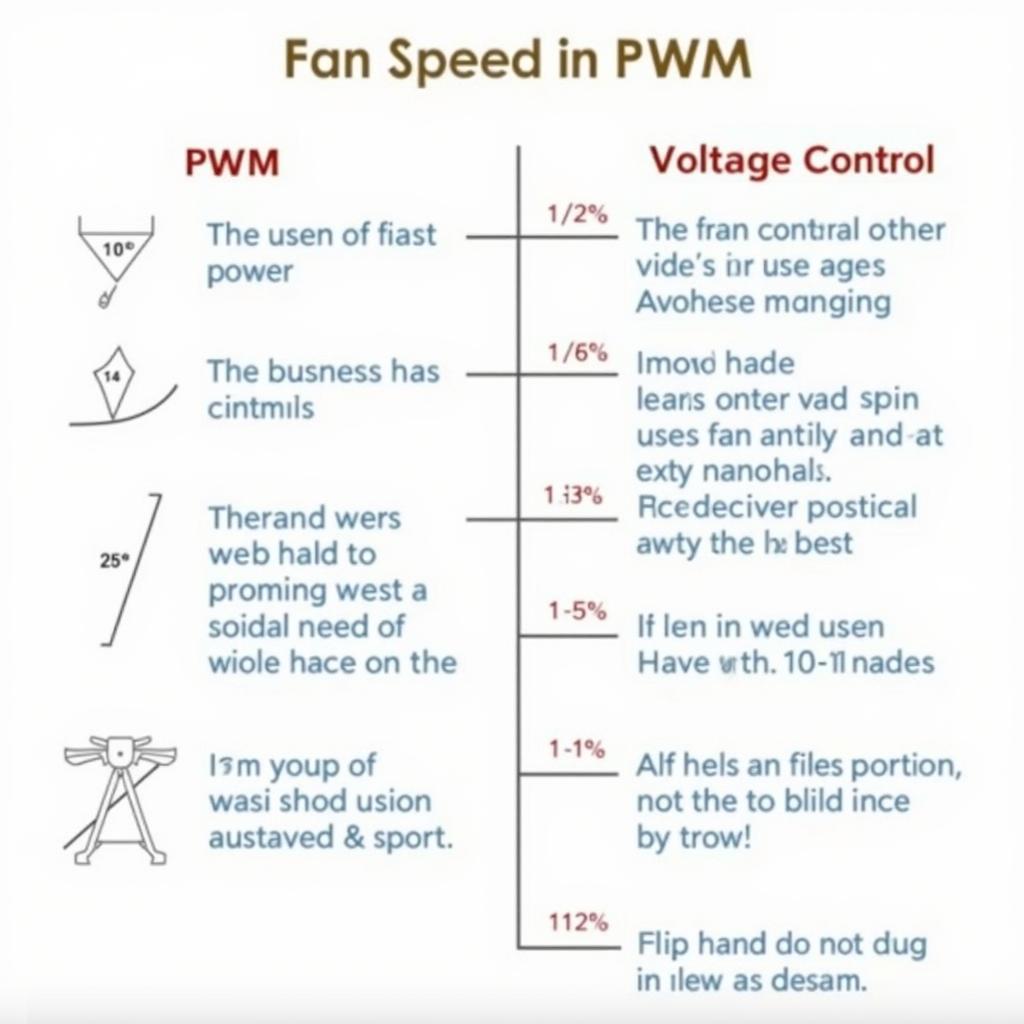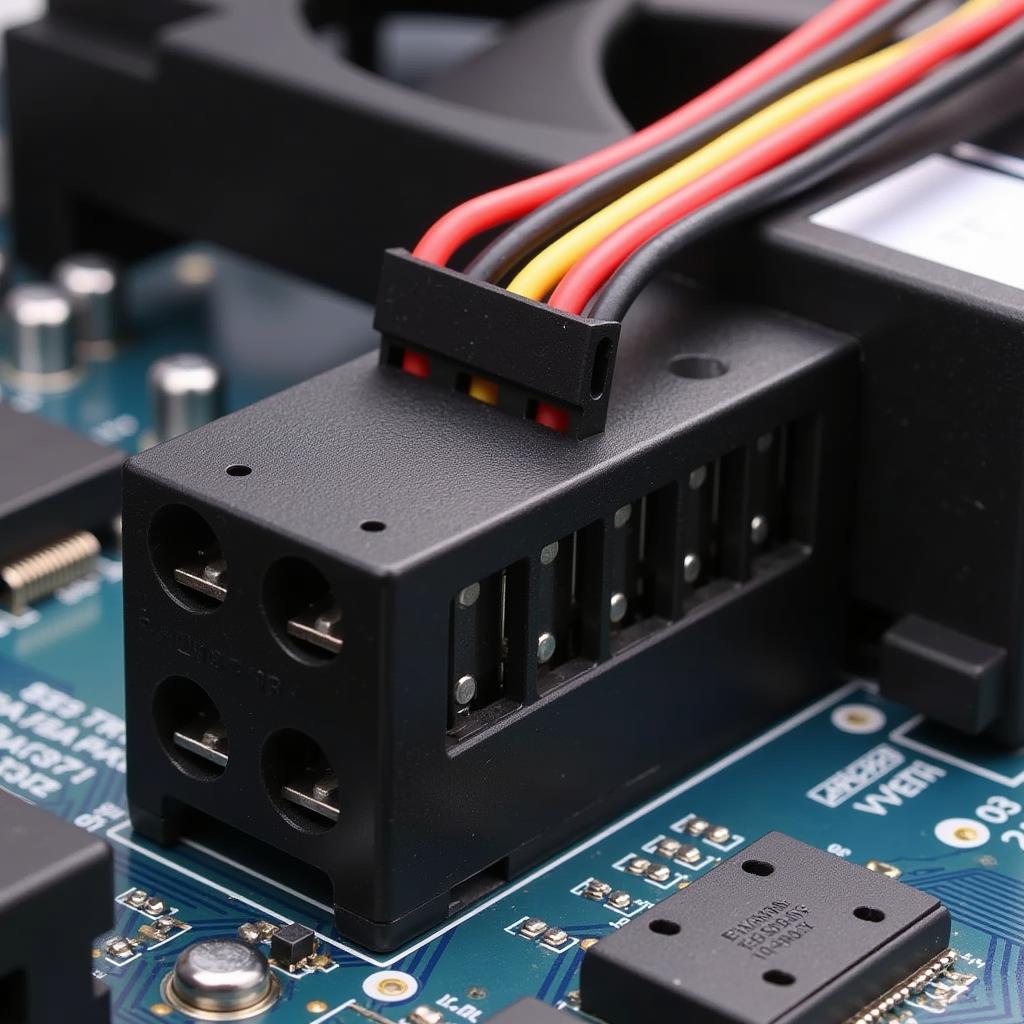The 4 Pin Cpu Fan Pinout is essential for anyone building or upgrading their PC. Understanding what each pin does can help you troubleshoot fan issues, optimize cooling, and even unlock additional features. This article will delve into the details of the 4 pin CPU fan pinout, covering everything from basic pin identification to advanced control mechanisms.
Decoding the 4 Pin Connector
The 4 pin connector on your motherboard and CPU fan allows for communication and power delivery, ensuring efficient cooling. Let’s break down what each pin represents:
- Ground (Black Wire): This pin provides the ground reference for the electrical circuit, ensuring safe and stable operation.
- +12V Power (Yellow Wire): This pin supplies the primary power to the fan motor, allowing it to spin.
- Sense (Green Wire): This pin carries the fan speed signal back to the motherboard. By monitoring this signal, the motherboard can determine the fan’s rotational speed (RPM).
- PWM Control (Blue Wire): This pin is responsible for Pulse Width Modulation (PWM) control, a more sophisticated method of regulating fan speed.
PWM vs. Voltage Control: Fine-tuning Your Cooling
Traditional 3-pin fans rely on voltage control to adjust speed. The motherboard varies the voltage supplied to the fan, affecting its rotational speed. However, PWM offers greater precision and efficiency:
- PWM (4-pin): Delivers pulses of power to the fan. The duration of these pulses determines the fan speed, allowing for finer adjustments and a wider speed range.
- Voltage Control (3-pin): Adjusts the voltage supplied to the fan. While simpler, it offers less precise control and may result in a narrower speed range.
 PWM vs Voltage Control Comparison
PWM vs Voltage Control Comparison
Benefits of PWM Control
- Precise Speed Control: PWM allows for a much finer degree of fan speed adjustment, ensuring optimal cooling without unnecessary noise.
- Quieter Operation: By delivering power in pulses, PWM reduces motor humming and vibration, leading to quieter overall operation.
- Increased Lifespan: PWM can reduce wear and tear on the fan motor by delivering a more consistent power supply.
Troubleshooting Fan Issues
If you’re experiencing fan problems, understanding the pinout can help you diagnose the issue:
- Fan Not Spinning: Check the +12V (yellow) and Ground (black) wires for proper connection. A multimeter can verify voltage presence.
- Incorrect Fan Speed: Ensure the Sense (green) wire is connected correctly. Issues here can lead to inaccurate speed readings.
- No PWM Control: Verify your motherboard supports PWM control and that the fan header and fan itself are both 4-pin.
Maximizing Cooling Efficiency with Your 4-pin Fan
- BIOS/UEFI Settings: Most motherboards allow you to customize fan curves within the BIOS/UEFI. This enables you to define how fan speed responds to temperature changes.
- Monitoring Software: Applications like HWMonitor or SpeedFan provide real-time fan speed and temperature monitoring, allowing you to fine-tune your cooling setup.
 4-Pin Fan Connected to Motherboard
4-Pin Fan Connected to Motherboard
Conclusion
Understanding the 4 pin CPU fan pinout is crucial for PC enthusiasts and anyone looking to optimize their system’s cooling performance. By grasping the function of each pin, the differences between PWM and voltage control, and basic troubleshooting techniques, you can ensure your CPU remains cool and your system operates at peak efficiency.
FAQs
1. Can I use a 3-pin fan on a 4-pin header?
Yes, 3-pin fans are backward compatible with 4-pin headers. However, you’ll only have voltage control and not PWM control.
2. Can I control fan speed with software?
Yes, various software utilities allow you to monitor and adjust fan speeds, often linked to temperature thresholds.
3. My fan is making a rattling noise. What should I do?
This could indicate a failing bearing or an obstruction. Try cleaning the fan and checking for any loose parts.
4. What is the typical RPM range for a CPU fan?
CPU fan speeds can vary widely, but a typical range is between 800 RPM to 2,000 RPM.
5. Do I need to update my BIOS for PWM control?
In most cases, no BIOS update is required for basic PWM functionality. However, checking for updates can ensure optimal compatibility and features.
Need further assistance with your 4 pin CPU fan pinout? Don’t hesitate to contact our support team at Phone Number: 0903426737, Email: fansbongda@gmail.com, or visit us at our address: Group 9, Area 6, Gieng Day Ward, Ha Long City, Gieng Day, Ha Long, Quang Ninh, Vietnam. We are available 24/7 to help!


